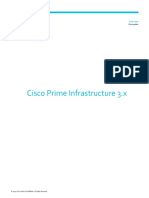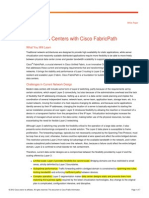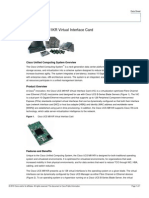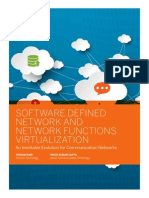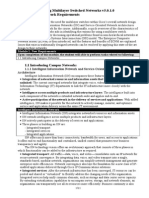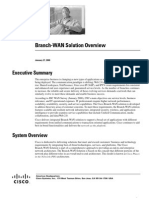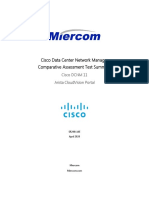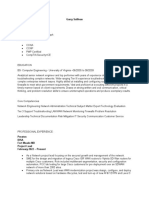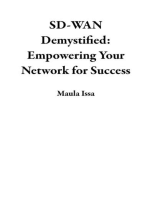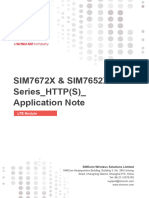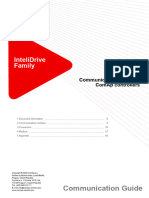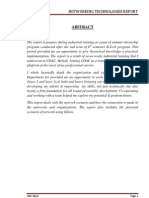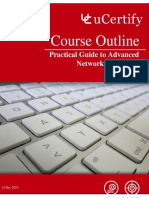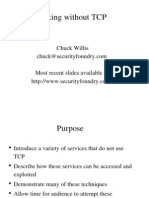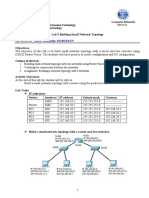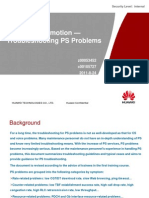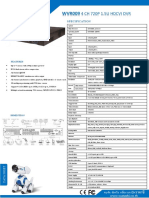Requirements For Campus and Data Center Switches
Requirements For Campus and Data Center Switches
Uploaded by
scribd0814Copyright:
Available Formats
Requirements For Campus and Data Center Switches
Requirements For Campus and Data Center Switches
Uploaded by
scribd0814Original Title
Copyright
Available Formats
Share this document
Did you find this document useful?
Is this content inappropriate?
Copyright:
Available Formats
Requirements For Campus and Data Center Switches
Requirements For Campus and Data Center Switches
Uploaded by
scribd0814Copyright:
Available Formats
Requirements for Campus and Data
Center Switches
Campus and data center switching networks differ in their
requirements. An understanding of the two deployments
and the specific requirements of each is imperative to
choose the right Cisco switch. Each deployment type
requires that switches have certain unique features. Table
1 compares the top five requirements for campus and
data center switches.
Table 1. Top Requirements for Campus and Data Center Switches
Campus Requirements
Met by Cisco Catalyst
Family and Cisco
IOS
Software
Data Center
Requirements Met by
Cisco Nexus
Family and
Cisco
NX-OS Software
User access control and
segmentation
Cloud security and virtual
machine awareness
Video intelligence Virtual machine mobility
Wired and wireless
convergence
LAN and SAN convergence
Application visibility Fabric scalability and
resilience
Power over Ethernet (PoE) Data center consolidation
The rest of this document discusses these features.
Campus
User Access Control and Segmentation
A campus or branch office is where users connect to
network wired or wirelessly, and every connection point
is vulnerable to security breaches. Capabilities to allow
access based on business policy, prevent users from
interfering with other users and their resources, isolate
infected and malicious devices and applications, and track
users in the network are crucial features of a campus
switch. Cisco Catalyst switches support IEEE 802.1x and
security group tags (SGTs), which automate authentication
and network segmentation for user groups and provide
access based on user roles. The switches, in conjunction
with Cisco Prime
applications, can help administrators
track and monitor every user. Additionally, Cisco Catalyst
6500 Series Switches support Easy Virtual Network
(EVN), which simplifies deployment of technologies such
as Multiprotocol Label Switching (MPLS), generic routing
encapsulation (GRE), and Virtual Routing and Forwarding
(VRF)Lite to segment users and groups in the network.
Video Intelligence
Globally, business web-based video conferencing
traffic is forecasted to grow six fold from 2011 to 2016,
a compounded aggregate growth rate (CAGR) of 45
percent
1
. Devices, such as computers, smartphones,
cameras, and dedicated Telepresence units, used to
send and receive video are proliferating. Helping ensure a
consistent experience and the capability to troubleshoot
problems are critical in all these scenarios, and the
network plays a major role. Cisco Catalyst switches have
Medianet features that enable lifecycle video solutions
to assess network readiness for video with built-in
IP service-level agreement (SLA) tools, automated
troubleshooting, and per-flow and per-hop flow metrics to
measure such factors as packet loss and network jitter.
Wired and Wireless Convergence
Controllers to manage wireless access points are
ubiquitous in campus and branch-office networks. These
controllers can be a physical or virtual appliance or
integrated into a LAN switch. The Cisco Catalyst 6500
Series supports the integrated Cisco Wireless Services
Module 2 (WISM2). Cisco also has standalone wireless
controllers that work in conjunction with the Cisco Catalyst
switches.
Application Visibility
The rising number of different applications places a
huge burden on the network. Congestion and outages
can occur, and network administrators need an accurate
way to track the application traffic flowing through the
network to troubleshoot and correct the situation. Cisco
Catalyst switches provide Cisco Flexible NetFlow, Network
Analysis Modules (NAMs), and Network-Based Application
Recognition (NBAR), which comprehensively scan the
traffic and offer reports based on protocols, applications,
and users.
Power over Ethernet
PoE is a technology through which power can be delivered
to end devices such as IP phones and access points from
a connected LAN switch through the LAN cable. Power
consumption can also be managed from a central location,
which helps conserve energy and reduce costs. Cisco
Catalyst switches support PoE, Enhanced PoE (PoE+),
and Cisco Universal PoE (CiscoUPOE
), which deliver 15
to 60 watts (W) per port. Cisco EnergyWise
technology
can be used to manage energy consumption of many end
devices connected to the switches.
Data Center
Cloud Security and Virtual Machine Awareness
As the number of virtual machines increases, so do
the challenges of configuring, administering, and
troubleshooting the networks that connect them. Because
todays networks have both physical and virtual servers
on them, visibility and awareness into both environments
is critical. Network policies, dictating everything from
quality-of-service (QoS) parameters to access control
lists (ACLs), define the way that clients and servers, as
well as their traffic, is supposed to behave on the network.
Historically, these policies wereapplied to physical
switch ports with physical servers connected to them.
2012 Cisco Systems, Inc. and/or its affiliates. Cisco and the Cisco logo are trademarks or registered trademarks of Cisco and/or its affiliates in the U.S. and other countries. To view a list of Cisco trademarks, go to this URL: www.cisco.com/go/trademarks.
Third party trademarks mentioned are the property of their respective owners. The use of the word partner does not imply a partnership relationship between Cisco and any other company. (1110R)
At-A-Glance
1. Cisco VNI Global IP Traffic Forecast, May 2012, at http://www.cisco.com/web/solutions/sp/vni/vni_forecast_highlights/index.html
As virtual servers move to different servers, on different
switches, perhaps in different data centers, deploying and
enforcing these policies becomes much more challenging.
These challenges spill over into other areas, such as
troubleshooting. The Cisco Nexus 1000V Series Switches
provide the solution to these problems by providing
visibility into the virtual machine environment while
extending the features and functions of the Cisco Nexus
portfolio. The Cisco Virtual Security Gateway (VSG) and
Cisco Adaptive Security Appliance (ASA) for Nexus 1000V
Series Switch work with the Cisco Nexus 1000V Series
to provide security capabilities such as firewalls, intrusion
protection systems (IPS), and VPN. These capabilities can
be used for multitenant solutions, thus providing cloud
environments with the tools they need to operate securely.
Virtual Machine Mobility
Not only does the network need awareness of virtual
machines; the network needs to enable the movement
of virtual machines: between servers, racks, or entire
data centers. Virtual machines may need to be moved for
several reasons, including providing business continuity,
resilience, and workload balancing. The techniques
for moving workloads typically do not traverse Layer 3
boundaries: that is, they require Layer 2adjacency. The
challenge with Layer 2 is that it typically requires Spanning
Tree Protocol, which often implies stability issues as the
environment scales. Features such as Overlay Transport
Virtualization (OTV) and Locator/ID Separation Protocol
(LISP) effectively address these issues by extending the
Layer 2 domain in a way that is scalable and stable and
does not rely on spanning tree. Thus, virtual machines
can move transparently across data centers, and the
environment will remain stable as it scales.
LAN and SAN Convergence
Traditional data centers often have separate LAN and
SAN infrastructures. However with the evolution of
virtualization, the challenges of shrinking data centers, and
the additional costs of managing two separate networks,
this model is evolving to a consolidated, single, networking
platform. The Cisco Nexus Family of data center switches
allows customers to build an infrastructure that allows
them to decrease their total cost of ownership (TCO)
through the simplification of data center architecture.
Through the convergence of the LAN and storage
networks, the Cisco Nexus portfolio delivers a high-
performance, highly scalable, lossless solution that can
carry Ethernet, Fiber Channel, Fiber Channel over Ethernet
(FCoE), Small Computer System Interface over IP (iSCSI),
and network-attached storage (NAS) traffic. This solution
allows reduction in the number of devices managed and
maintained, reduced cabling requirements, and more
efficient resource utilization, leading to lower power and
cooling costs.
Fabric Scale and Resilience
To build an agile, highly available infrastructure that
delivers both reduced TCO and a solution that can adapt
to future needs, you must be able to scale the data center
performance and port bandwidth while reducing costs
and complexity and to create an architecture that can
withstand planned and unplanned downtime. The Cisco
Nexus portfolio offers multidimensional scalability for
the data center network in switch performance, system
scalability, and geographic span, allowing your data center
to support more servers and more applications when
you need them. Through support for high-density 1, 10,
40, and 100 Gigabit Ethernet connectivity that can be
deployed at the aggregation layer, core, top of the rack,
middle of the rack, or end ofthe row and as an embedded
virtual switch integrated into your server hypervisor, this
highly flexible portfolio enables customers to create the
right architecture with the right types of connectivity
speeds that they need today, with a solution that can
address evolving needs.
When customers couple scalability technologies such as
Cisco FabricPath with Cisco Nexus hardwarearchitecture
redundancy, Cisco NX-OS process modularity, hitless
In-Service Software Upgrade(ISSU), and self-healing
capabilities, customerscan take full advantage of a highly
available architecture with no service disruption, allowing
them to quickly integrate new features, enhancements,
and problem fixes, providing a solution that makes zero-
impact operations a reality.
Data Center Consolidation
The data center is the heart of a business; any downtime
(planned or unplanned) can severely affect profitability.
Beyond network-based availability, the combination of
Cisco Nexus hardware architecture redundancy and Cisco
NX-OS process modularity and self-healing capabilities,
you can take full advantage of a highly available
architecture with no service disruption. Throughthe
solutions capability to help ensure continuous uptime
for planned and unplanned maintenance, upgrades, and
software certification, and through technologies such as
Ciscos ISSU capabilities, you can quickly integrate new
features, enhancements, and problem fixes, providing a
solution that makes zero-impact operations a reality.
Common Features
The campus and data center also require features that are
common to both of them, such as simplified management,
programmability, high-availability, and Cisco TrustSec
capabilities.
When choosing a Cisco switch for the campus or
data center, choose the switch based on the features
discussed in this document to gain the greatest benefit
and lowest TCO.
For More Information
www.cisco.com/go/switching
At-A-Glance
2012 Cisco Systems, Inc. and/or its affiliates. Cisco and the Cisco logo are trademarks or registered trademarks of Cisco and/or its affiliates in the U.S. and other countries. To view a list of Cisco trademarks, go to this URL: www.cisco.com/go/trademarks.
Third party trademarks mentioned are the property of their respective owners. The use of the word partner does not imply a partnership relationship between Cisco and any other company. (1110R) C45-716756-00 09/12
You might also like
- Ixia Vision E40 E100 User Guide v5.0.0Document526 pagesIxia Vision E40 E100 User Guide v5.0.0pham hai van100% (3)
- Anti LAG Script - Edited by JoseDocument3 pagesAnti LAG Script - Edited by JoseJose Gellado100% (1)
- RTN 380A&380AX V100R009C10 Feature Description 02 PDFDocument289 pagesRTN 380A&380AX V100R009C10 Feature Description 02 PDFSaeed Ashraf KhanNo ratings yet
- Learning SD-WAN with Cisco: Transform Your Existing WAN Into a Cost-effective NetworkFrom EverandLearning SD-WAN with Cisco: Transform Your Existing WAN Into a Cost-effective NetworkNo ratings yet
- Software Defined Networks and OpenFlowDocument105 pagesSoftware Defined Networks and OpenFlowaseaudiNo ratings yet
- High Speed 300Mbps Super Long Range Wireless Ceiling Access Point Model: ACP-2405n FeaturesDocument2 pagesHigh Speed 300Mbps Super Long Range Wireless Ceiling Access Point Model: ACP-2405n FeaturesmaecassiopeiaNo ratings yet
- Cisco Controller Based WLANDocument4 pagesCisco Controller Based WLANjumyarif2905No ratings yet
- Cisco Prime Infrastructure 3.xDocument5 pagesCisco Prime Infrastructure 3.xC KNo ratings yet
- Cisco FabricPath White PaperDocument7 pagesCisco FabricPath White PaperRob LambertNo ratings yet
- Deploy Cisco UCS X210c Compute Node With Cisco Intersight Management Mode For VDIDocument36 pagesDeploy Cisco UCS X210c Compute Node With Cisco Intersight Management Mode For VDIMemduh DeliormanliNo ratings yet
- Data Sheet c78 525049 Virtual Interface CardDocument4 pagesData Sheet c78 525049 Virtual Interface CardChiTownITNo ratings yet
- Software Defined Network and Network Functions VirtualizationDocument16 pagesSoftware Defined Network and Network Functions VirtualizationSaksbjørn Ihle100% (1)
- LAN Design Guide For The Midmarket: Esign Mplementation UideDocument13 pagesLAN Design Guide For The Midmarket: Esign Mplementation UideDuong PhamNo ratings yet
- Cisco CSR in Aws WhitepaperDocument21 pagesCisco CSR in Aws WhitepaperKamalSinghNo ratings yet
- 6WIND-Intel White Paper - Optimized Data Plane Processing Solutions Using The Intel® DPDK v2Document8 pages6WIND-Intel White Paper - Optimized Data Plane Processing Solutions Using The Intel® DPDK v2ramanj123No ratings yet
- Cisco Prime Network Control System 12Document12 pagesCisco Prime Network Control System 12vampziNo ratings yet
- CCNP BMSN Cap.1Document11 pagesCCNP BMSN Cap.1Vadan CorneliuNo ratings yet
- Data Center Design-IP Network InfrastructureDocument70 pagesData Center Design-IP Network InfrastructureDema PermanaNo ratings yet
- Exploration LAN Switching Chapter1Document31 pagesExploration LAN Switching Chapter1Sahan DininduNo ratings yet
- datasheet-c78-744052Document20 pagesdatasheet-c78-744052TarunTaunkNo ratings yet
- DC Caves 20210Document7 pagesDC Caves 20210aluranaNo ratings yet
- Network +security L3 - Computa CenterDocument9 pagesNetwork +security L3 - Computa CenterAsifNo ratings yet
- Cisco 5520 Wireless Controller Data SheetDocument7 pagesCisco 5520 Wireless Controller Data SheetPhyo Min TunNo ratings yet
- NB 06 Cat9300 Ser Data Sheet Cte enDocument68 pagesNB 06 Cat9300 Ser Data Sheet Cte enboydNo ratings yet
- Branch-WAN Solution Overview: Executive SummaryDocument24 pagesBranch-WAN Solution Overview: Executive SummarySteveihNo ratings yet
- Data Center Switching Solutions White PaperDocument15 pagesData Center Switching Solutions White PaperBon Tran HongNo ratings yet
- Chapter ThreeDocument10 pagesChapter Threemustefa endrisNo ratings yet
- Cisco Catalyst 9300 DatasheetDocument24 pagesCisco Catalyst 9300 DatasheetThuc PhanNo ratings yet
- Analyzing The Cisco Enterprise Campus Architecture: CCNP SWITCH: Implementing IP SwitchingDocument33 pagesAnalyzing The Cisco Enterprise Campus Architecture: CCNP SWITCH: Implementing IP SwitchingYiannis NeocleousNo ratings yet
- ITNE 3006 - AssignmentDocument13 pagesITNE 3006 - AssignmentSadia AbdullahNo ratings yet
- The RoadMap To Cisco ACI Whys and WhereforesDocument24 pagesThe RoadMap To Cisco ACI Whys and Whereforesravi kantNo ratings yet
- Cisco Catalyst 9300 Series Switches: Built For Security, Iot, Mobility, and CloudDocument23 pagesCisco Catalyst 9300 Series Switches: Built For Security, Iot, Mobility, and CloudVictorius ApiladoNo ratings yet
- Sumit Ahuja ResumeDocument6 pagesSumit Ahuja ResumeMandeep BakshiNo ratings yet
- Scalable Cloud Network With Cisco Nexus 1000V Series Switches and VXLANDocument4 pagesScalable Cloud Network With Cisco Nexus 1000V Series Switches and VXLANAnonymous taUuBikNo ratings yet
- Cisco Data Center Network Manager Comparative Assessment Test SummaryDocument9 pagesCisco Data Center Network Manager Comparative Assessment Test SummaryNgọc Duy VõNo ratings yet
- Cisco 350X Series Stackable Managed SwitchesDocument32 pagesCisco 350X Series Stackable Managed SwitchesTheerapatNo ratings yet
- CCNP Switch Ch01Document33 pagesCCNP Switch Ch01Latanya Beard100% (1)
- Data Redundancy Elimination (DRE) Technology To Identify: Secure ConnectivityDocument15 pagesData Redundancy Elimination (DRE) Technology To Identify: Secure ConnectivityPriscila FloresNo ratings yet
- SW Ch01Document33 pagesSW Ch01Fabio QuintanaNo ratings yet
- Garry SullivanDocument6 pagesGarry SullivanMeganNo ratings yet
- Research Paper On LanDocument6 pagesResearch Paper On Lanc9kb0esz100% (1)
- Network TransformationDocument6 pagesNetwork TransformationMumtaz AhmadNo ratings yet
- SD-Access WirelessDocument118 pagesSD-Access WirelessAhmad Al-MashaikhNo ratings yet
- Cisco Catalyst Fixed-Configuration SwitchesDocument17 pagesCisco Catalyst Fixed-Configuration SwitchesAis MeaNo ratings yet
- Cisco Catalyst 9300 Series Switches Data SheetDocument23 pagesCisco Catalyst 9300 Series Switches Data SheetKristine AbanadorNo ratings yet
- NexusDocument17 pagesNexusVignesh ReddyNo ratings yet
- Cisco Overlay TechnologyDocument19 pagesCisco Overlay TechnologyRajatNo ratings yet
- Network Virtualization-Path Isolation Design GuideDocument252 pagesNetwork Virtualization-Path Isolation Design GuideCatalin ApostolNo ratings yet
- Enterprise Networking SolutionDocument14 pagesEnterprise Networking SolutiongsandiwNo ratings yet
- What Is Unified Fabric?Document2 pagesWhat Is Unified Fabric?sudhakaremcNo ratings yet
- Module1 - Scalable Network DesignDocument26 pagesModule1 - Scalable Network DesignGerryNo ratings yet
- Cisco Switch 9300 - DatasheetDocument61 pagesCisco Switch 9300 - DatasheetJose RojasNo ratings yet
- Cisco Sdwan Design GuideDocument101 pagesCisco Sdwan Design GuideporurrajeshudtNo ratings yet
- Cisco Virtualized Multiservice Data Center-White - PaperDocument16 pagesCisco Virtualized Multiservice Data Center-White - Paperpremprakash23No ratings yet
- Path IsolDocument252 pagesPath IsolDavid HicksNo ratings yet
- Idc Ethernet Fabric WPDocument10 pagesIdc Ethernet Fabric WPthatseasy123No ratings yet
- Datasheet c78 738512Document14 pagesDatasheet c78 738512Gabriela PopescuNo ratings yet
- Next-Generation switching OS configuration and management: Troubleshooting NX-OS in Enterprise EnvironmentsFrom EverandNext-Generation switching OS configuration and management: Troubleshooting NX-OS in Enterprise EnvironmentsNo ratings yet
- Cisco Networks: Engineers' Handbook of Routing, Switching, and Security with IOS, NX-OS, and ASAFrom EverandCisco Networks: Engineers' Handbook of Routing, Switching, and Security with IOS, NX-OS, and ASANo ratings yet
- Software Defined Networking (SDN) - a definitive guideFrom EverandSoftware Defined Networking (SDN) - a definitive guideRating: 2 out of 5 stars2/5 (2)
- Fortiswitch v3.6.11 Release NotesDocument16 pagesFortiswitch v3.6.11 Release NotesabelNo ratings yet
- Chapter 18 Omron - CS CJ PLCDocument25 pagesChapter 18 Omron - CS CJ PLCJesús Manuel De León HernándezNo ratings yet
- SIM7672X & SIM7652X Series - HTTP (S) - Application Note - V1.00Document36 pagesSIM7672X & SIM7652X Series - HTTP (S) - Application Note - V1.00freetracker85No ratings yet
- Fast Lane - CI-BGPDocument3 pagesFast Lane - CI-BGPYe HtetNo ratings yet
- CNLab4 2021 CE 40Document15 pagesCNLab4 2021 CE 40malikabdullah1082No ratings yet
- Traffic Engineering 1Document2 pagesTraffic Engineering 1Habet MoshmoshNo ratings yet
- Metropolitan Area NetworksDocument26 pagesMetropolitan Area NetworksMayur BhagatNo ratings yet
- Manual To Use SFTPDocument7 pagesManual To Use SFTPmailcongcongNo ratings yet
- Openscape Business V2: How To Configure Sip Trunk For Netfone HungaryDocument14 pagesOpenscape Business V2: How To Configure Sip Trunk For Netfone HungaryBelahreche MohamedNo ratings yet
- OptimDocument6 pagesOptimOlanNo ratings yet
- D. NGN Architecture - NGN Functional Model: Application Servers Management ServersDocument29 pagesD. NGN Architecture - NGN Functional Model: Application Servers Management ServersHani Mohammed Al-olofiNo ratings yet
- Sophos Firewall - Devices Not Getting Dynamic DHCP Lease - Liberar Escopo Global Do DHCPDocument2 pagesSophos Firewall - Devices Not Getting Dynamic DHCP Lease - Liberar Escopo Global Do DHCPAntonioNo ratings yet
- ID Communication Guide - 2Document118 pagesID Communication Guide - 2AndrewNo ratings yet
- Project ReportDocument41 pagesProject ReportNupur Nidhi100% (1)
- Course Outline: Practical Guide To Advanced NetworkingDocument15 pagesCourse Outline: Practical Guide To Advanced NetworkingcodytlseNo ratings yet
- Hacking Without TCP SlidesDocument88 pagesHacking Without TCP SlidesMrityunjay SharmaNo ratings yet
- IP AddressingDocument60 pagesIP AddressingrenjithkalaNo ratings yet
- Pa 5200 SeriesDocument6 pagesPa 5200 SeriesnnNo ratings yet
- Sonicos and Sonicosx 7 Users: Administration Guide For The TZ and NSV SeriesDocument39 pagesSonicos and Sonicosx 7 Users: Administration Guide For The TZ and NSV SeriesIT DepartmentNo ratings yet
- Lab4 - Packet TracerDocument2 pagesLab4 - Packet TracerIenei Csongor AttilaNo ratings yet
- ICND120SG Vol2Document138 pagesICND120SG Vol2khoaNo ratings yet
- UMTS Troubleshooting PS Problems 201111Document68 pagesUMTS Troubleshooting PS Problems 201111shindeleNo ratings yet
- An Introduction To Megaco/H.248: Tom TaylorDocument22 pagesAn Introduction To Megaco/H.248: Tom TaylorterzihaneNo ratings yet
- DataPower 70 NetworkingDocument39 pagesDataPower 70 NetworkingAdmin sdNo ratings yet
- Manual ILC 151Document132 pagesManual ILC 151Cristian PisitelloNo ratings yet
- WWW - Watashi.co - TH: SpecificationDocument1 pageWWW - Watashi.co - TH: Specificationapi-356394149No ratings yet







